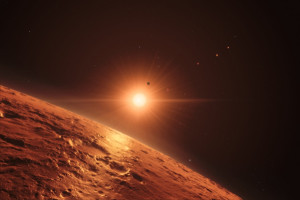Research
I’m interested in planets outside the solar system (exoplanets), their host stars, and how these systems behave over time. My group uses observational data all over the electromagnetic spectrum from space-based and ground-based telescopes to study star-exoplanet systems.
Exoplanet atmospheres

Atmospheres of exoplanets can be studied through a variety of observational methods, for example transits of exoplanets in front of their host stars, or their eclipses when they are hidden behind the star. The signatures at different wavelengths give us clues about atomic species and densities at different altitudes in the atmosphere. However, the star is not a constant “background candle”; stellar magnetic activity can cause short-tern and long-term changes in the stellar spectrum, which we need to understand and characterize to extract the exoplanetary features correctly.
Stellar magnetism
Stars with an outer convective zone like the Sun produce strong, highly structured magnetic fields through a magnetic dynamo process. These magnetic fields cause star spots, flares, coronal mass ejections, and are the cause for the hot outer layers of stars, the chromosphere and corona. To understand the heating processes and sudden energy release by magnetic flares, we use X-ray observations of stellar coronae. These processes can also have a strong influence on planets in close orbits around their host stars, because high-energy irradiation is the main driver for atmospheric evaporation.
Star-Planet Interactions
Planets in close orbits around their host stars can influence the stars through tidal or magnetic interactions. Tidal interactions are thought to change the rotational evolution of a host star, while magnetic interactions are thought to manifest themselves as temporary phenomena of magnetic activity such as planet-triggered flares or local hot spots in the outer stellar atmosphere layers. Since also the purely stellar evolution of rotation and magnetic activity has a significant stochastic element, measuring star-planet interaction requires carefully selected samples and suitable statistical methods. Samples of wide stellar binaries with and without known planets as well as large flare catalogs from space-based light curves are important tools in my group to investigate star-planet interactions.
Habitability of exoplanets
Planets around other stars often experience very different space weather conditions than our rather tepid Earth. Especially in systems where the host star is a red dwarf and the habitable zone is close to the star, the magnetic activity of the star can influence the chances for life to develop. My group uses observations and simulations to study how stable such atmospheres can be over long timescales.
Some current research projects pursued in my group are:
– evolution of rotation and magnetic activity of old cool stars
– exoplanet discovery through transit observations
– studies of exoplanets around young and active stars
– high-resolution spectroscopy of exoplanet atmospheres
– flare occurrences in stellar clusters and exoplanet host stars
– stellar binaries as testbeds for star-planet evolution